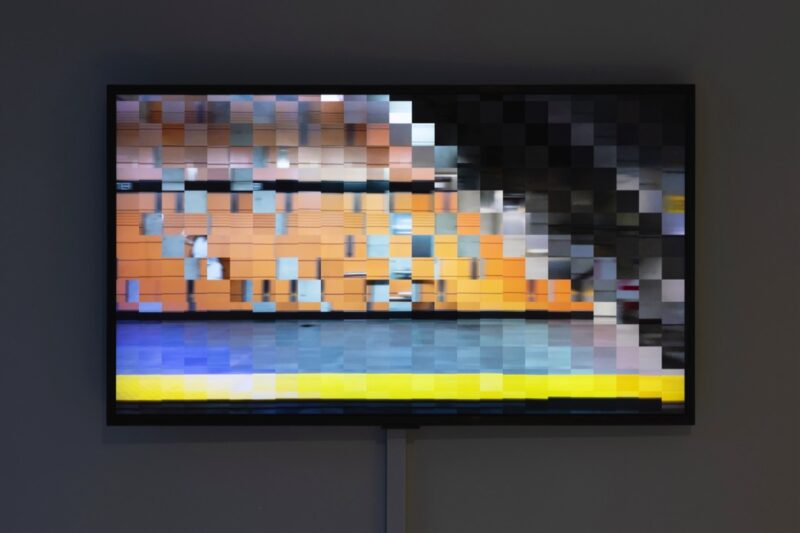[Fall 2024]
Nathalie Bujold, Métroscopies
by Sylvain Campeau
Ellephant, Montréal
31.01.2024 — 16.03.2024
[EXCERPT]
In 2020, as the pandemic was raging, Nathalie Bujold decided to take advantage of the situation as best she could. Fascinated by the Montreal metro, which has been part of how people get around the city since 1966, she explored it from end to end and tried to figure out how she could portray its plasticity and mobility. The context was favourable: fewer people were riding and, above all, mandatory mask wearing made it acceptable to encroach on and film faces.
Bujold’s approach to video-recording reality was systematic and practical. Armed with just a cell phone, she conducted a rigorous operation that she called an “attempt to fully document” this highly significant place with a familiar visual signature. The four metro lines and sixty-eight stations thus made their way into this eleven-screen exhibition in videos lasting a total of seventy-seven minutes. To provide the grouping with a coherent vision and consistency, Bujold adopted a defined positioning within the trains she rode and ensured that something interesting, a significant detail, and human presences characteristic of how this type of transportation is used would be revealed at each station stop.
She also faced a thorny problem. The lines are not composed of an equal number of stations and are not all the same length. There would have to be aesthetic and formal choices made to convey the network’s configuration. The blue line was presented on three screens, with a four-minute video. The orange line took up four screens, with three videos lasting ten minutes or more, and the fourth, devoted to the Laval section, only two minutes and twenty-three seconds long. The yellow line took up a single screen, with a video lasting five minutes and nineteen seconds. The last line, the green, was also presented on a single screen, and its video lasted twenty-six minutes and thirty-six seconds. The speed wasn’t the same from one line to the next, and some screens were larger than others; the viewer’s experience varied, as some videos revealed the coating of the image and the edges of the coloured squares. This was so for the yellow line, with the fewest stations: it wasn’t so much the speed that drew the eye as the slower deployment of the squares. The time – and the images – is cut up less quickly and the cubist movement is more languorous, allowing more to be seen. Viewers then had room to wonder whether this mash-up wasn’t revealing another image, one that we usually struggle to see and that might be hinted at here: the latent image, the plasticity of views, that constant movement robs us of.
All these choices confer both unity and diversity on the installation as a whole. Unity, because the general look is cohesive; diversity, because the rhythms and durations vary, as do the places we can make out, the passersby we see – the details of what, in the end, we know very well. Mainly, it’s all about movement: the images are still only during the station stops. When the train starts again, the image decomposes into a multitude of small squares scrolling by more and more quickly, following the acceleration of the train as it heads for the next station. These forms resemble obese pixels; Bujold has fattened them. It is as if the image disintegrates and is reconstructed, disturbed or discomfited by motion as it follows the train’s speeding up and slowing down. We then recognize what these fluctuations consist of, and we know them very well. Then, it is colours and lines, forms and compositions, the details of an access point where passengers loom, that project us into the familiarity of this environment.
This is, obviously, an ode celebrating the metro, singing the praises of its movement. It beguiles us by putting us in tune with what actually transports us (or coaxes or shakes us, or makes our heads nod) on our outings, our comings and goings. It is if Bujold went to the very core of the metro’s colour and motility, and of the time we spend travelling on it. It renders its content in a kind of kaleidoscope that, once the skin of realism is removed, dwells on the shapes, colours, and rhythms of what we experience. Translated by Käthe Roth
[ Complete issue, in print and digital version, available here: Ciel variable 127 – SISTERS, FIGHTERS, QUEENS ] [ Complete article in digital version available here: Nathalie Bujold, Métroscopies]



